China’s Maritime Ambitions: Implications for Regional Security
By SAAG
By Commodore R. S. Vasan
“Imagine six centuries ago, a mighty armada of Zheng He’s ships crossing the China Sea, and then venturing west to Ceylon, Arabia, and East Africa. The fleet consisting of giant nine-masted junks, escorted by dozens of supply ships, water tankers, transports for cavalry horses, and patrol boats. Loaded with Chinese silk and porcelain, the junks visited ports around the Indian Ocean” – As recorded in “Muslim Heritage”
Many China analysts are aware that the interest of the Chinese in Indian Ocean is not a new phenomenon. One has to only go back to the historical voyages of Chinese Admiral Zheng He (1371-1433) who undertook seven voyages and visited 37 countries while he commanded the Chinese fleet from the middle kingdom. It is noteworthy that the fleet visited countries in Africa, Persia and the Indian Coastal Regions, thereby practicing both forward presence and flag showing. As per recorded history, these voyages pre date those of Vasco-Da-Gama and Columbus clearly illustrating the rich maritime traditions of the Chinese Sea farers centuries ago. As per the reports, it has been brought out that the vessels were large junkets of over 400 feet in length and were able to undertake long arduous ocean voyages carrying merchandise and accompanied by a supporting fleet to far corners of the world. In the light of this recorded history, it is not a surprise that there is resurgence of Chinese interest in the Indian Ocean and in maritime matters driven by a desire to protect their shipping and global interests. The most important aspect of China’s maritime security today is driven by considerations of energy security and concerns on the vulnerability of long winding energy supply chains as they carry these vital products from distant shores.
Present day Compulsions for return to IOR
It is a matter of great interest to examine the present day compulsions for return to Indian Ocean region after over six centuries in greater detail. These factors are discussed below:-
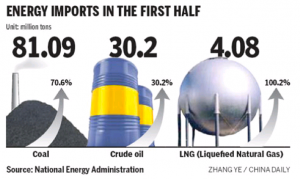
a. Peaceful development.
China has asserted that it believes in peaceful development. However, most nations remain naturally suspicious of Chinese intent. The concept of peaceful development has been assessed as a ploy for buying peace on its terms, while it prepares for war by spending phenomenal money on military modernisation, infrastructure and capacity building. Economic engagements as part of the peaceful development have reached far corners of the world as is evident by enormous investments in the maritime sector. China would be in a position to extract certain concessions from these countries due to the nature of assistance being provided to developing countries in Asia and Africa. In many cases, the beneficiary countries have been given soft loans and or other incentives to ensure that the long term interests of China are protected. The constant impressive GDP growth and the phenomenal money being spent on military acquisitions and modernizations do not lend any hope about the intentions of China which has surpassed Japan as the second largest economy after USA.

b. Energy dependence.
As highlighted above, this factor would be uppermost while planning for energy security to maintain and improve the phenomenal double digit growth in terms of GDP. The figure below as provided by China Daily is indicative of the extent of dependence on energy products. Unfortunately for China, even today a major chunk of these inputs have to come through the sea routes.
Also, as illustrated in the World Energy Outlook graph, it is clear that India and China’s net import dependence would be 90 % and 78 percent respectively in the next three decades.
The dependence therefore of the two Asian countries would be of such magnitude as to bring out a keen sense of competition to scout for energy products around the world and provide energy security at whatever cost. The keen competition could fuel tensions between nations particularly in disputed areas which may contain high yields of oil, gas and minerals. The industrial might and capacity would come to a naught if China is not able to provide energy products to sustain its industry. This is also true of other developing countries including India, its southern neighbour.

c. India’s growth as a pre-eminent maritime power.
While China’s focus and preoccupation is still with US, Taiwan, Japan and its maritime neighbours, China has always been weary of India’s growth and is also suspicious of India’s recent strategic alliance with US and engagement with its maritime neighbours including Japan and Vietnam. China is worried about a possible US led initiative and possible use of India’s maritime forces to contain China. The geo strategic advantage enjoyed by India which provides excellent reconnaissance and intervention potential, a modern Regional Navy and its strategic outpost in Andaman and Nicobar close to Malacca Straits are sources of concern to China which is disadvantaged in terms of its maritime access to IOR through the Malacca Straits. The maritime forces which operate in the South China Sea would need to pass under the scrutinizing gaze of not just the South Eastern countries but also India which has a strategic Tri services command at the Andaman and Nicobar Island with a credible I2SR (Intelligence, Information, Surveillance and Reconnaissance) architecture controlled by the Tri Services Commander who commands all the defence service components located in the A&N Islands

SLOC Vulnerability.
Nearly 80 percent of China’s imports from around the world are through the sea routes and the SLOCs pass through the straits on either side of India (Straits of Hormuz and Malacca Straits). The figure to the right indicates the sea routes with reference to the South China Sea.
The graph to the right illustrates the near term oil import needs that would cross 10mn barrels per day (BPD).
This would translate to hundreds of Chinese ships moving to China from different parts of the world on a daily basis.
The sources which are distributed in different parts of the world from which China imports its crude range from Angola to Venezuela and is the extent of import from A to Z countries is indicated below:
It is this soft belly of maritime enterprise that is worrisome for China.
China perceives a sense of vulnerability as most of its goods are carried in their own ships. There are genuine concerns about the vulnerability of its sea borne assets to acts of maritime terrorism and piracy.
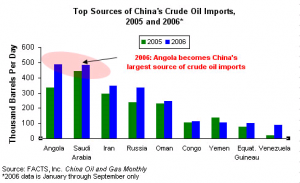
Passage through the Malacca Straits and Straits of Hormuz, the maritime life lines and arteries of the world shipping traffic will continue to be source of serious concern. The investment in Gwadar, Hambanthota, Ports in Bangladesh and Myanmar would therefore need to be looked at as investments for future contingencies and not just as pure economic investments. What is today an economic investment on easy terms to the host nation has the potential of translating to use of these ports during times of hostility. It requires no special skills to analyse the fact that China is insuring its future energy security by being in a position to deploy its naval units next to choke points where its interests may be threatened. So it is Gwadar that would provide such an option close to the Strait of Hormuz as its oil carrying ships exit from the oil rich countries. Gwadar would also provide the option for providing security cover to future developments in Central Asian Republics related to energy security. Hambanthotta in Sri Lanka is being developed as a deep water port and its importance lies in the location in the Indian Ocean as it overlooks the SLOCs that crisscross the southern Indian Ocean. India would be ruing the fact that it let go of an opportunity to invest in Hambanthotta . It is clear that its calculations of India have misfired on all counts in the constituency of Mahinda Rajapaksa. It has been suggested that the lumbering bureaucracy of India bungled this opportunity and paid dearly by allowing inroads to China in areas that India considers as its back yard. India displayed its bankruptcy in strategic thinking by creating a vacuum for China to occupy.
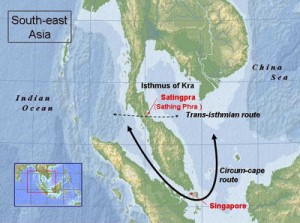
China has also provided soft loans and collaborative support to development of ports in Myanmar and Bangladesh. However, these ports in addition to providing a foot hold in Bay of Bengal at a later date, presently would meet the requirement of linking up the energy products from the rich oil fields in Myanmar to its Kunming areas.
d. Alternatives.
China has also attempted to bring down its vulnerability to the sea routes by developing alternate pipe systems over the land routes and also new sea routes. China has acquired oil and gas fields around the world and also has built up a huge strategic reserve of oil, gas and coal. A great deal of emphasis is being laid on ensuring that the vulnerability of the sea routes is minimized. Some of the alternate plans discussed below are also due to the delays in the Kra Isthumus project due to various reasons.
The figure below indicates plans for linking up of the Bay of Bengal ports in Myanmar with its Kunming province by a network of oil and gas pipelines.
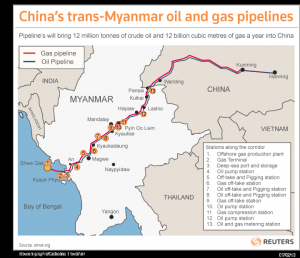
This would facilitate large ships carrying crude/LNG to avoid the Malacca Straits and berth in one of the deep water ports and pump the energy products to China.
The rich oil and gas fields in the region could also be carried to China directly from Myanmar/Bangladesh.
The figure indicates its alternate routes being developed through the Central Asian Republics and Russia to provide energy pipe lines over land.
e. Pursuance of policy of Encirclement.
The investments in the port and maritime infrastructure in many neighbouring countries of India has to be seen in the light of the vulnerability discussed above.
The use of term “String of Pearls” has come to stay and has negative connotations in the context of maritime security in the IOR.
One could compare the string of pearls to a loose noose which can be tightened as and when so necessitated.

The aspects of the future potential of some of these dependency ports(so termed by Admiral S Mehta, Former Naval Chief of India) have been discussed above while examining issues of SLOC vulnerability.
The diagram below illustrates the extent of planning that has gone in to the Chinese maritime ambitions in the Indian Ocean Region.
Though not shown in the diagram, China is also wooing other Indian Ocean Nations by economic investments and offer of development.
Mauritius and Seychelles have been engaged actively by China to counter the Indian influence in these countries which have traditionally enjoyed excellent relations in many fields.
From the Chinese point of view, they are strictly following the prescriptions of Chanakya who advocated friendship with the enemies or neighbours of your potential adversary.

f. Fears of Strategic alliance among big powers.
The US led initiative way back in 2007 for holding a quadrilateral exercise in the Bay of Bengal was viewed with great suspicion and China protested such grouping of a democratic dispensation? During the quadrilateral exercise, in addition to US which mooted the idea, India, Australia, UK and Singapore participated. For reasons of not offending the Chinese sensitivity, this exercise has not been repeated since. In the opinion of this author, there was no such reason for calling off a well meaning exercise. The Bay of Bengal area has always been known for the vagaries of weather and one routinely faces maritime disasters of various dimensions.
The Tsunami of 2004 also demanded that the maritime forces come together and be prepared to render timely assistance in times of such calamity. So the exercise such as the one undertaken should continue on the basis of building regional capacity for Humanitarian Assistance and Disaster Relief (HADR). It is time that India stepped in and wrest the initiative afresh.
g. Fears of maritime piracy and terrorism.
The growing incidents of acts of maritime piracy particularly in the Gulf of Aden off the African coast has brought in maritime forces of various countries to the region to provide a protective shield to the large number of merchant ships that are plying the oceans crisscrossing the oceans. From the point of view of China, it has deployed its modern ships in rotation since end of 2008. On the return passage, the Chinese ships have also visited ports in India and other friendly countries. This has enabled its maritime forces to gain invaluable experience and familiarize with the areas of operation in Indian Ocean Region. The recording of the experiences of the Navy would enable PLA Navy to redefine their Standard Operating Procedures(SOPs).Data bases assiduously built over the last two years would enable storing and analysis of wide range of oceanographic, bathymetric, weather related and topographic data that would help the PLA Navy to plan for the future.

Conflicts-Aggressive Stance.
China unfortunately has a history of conflict with most of its neighbours on issues of ownership of territories and on issues of demarcation of boundaries. The extent of dispute is listed below:
Coastal Area– disputed by Thailand, Vietnam, the Philippines and China.
Gulf of Tonkin – disputed by China, Vietnam
Paracel Islands – disputed by People’s Republic of China, Republic of China (Taiwan), Vietnam
Spratly Islands – disputed by People’s Republic of China, Republic of China (Taiwan), Malaysia, the Philippines, Vietnam, and Brunei
The main issues of maritime dispute with China are related to Coastal areas disputed by Vietnam, Thailand and Philippines, Gulf of Tonkin disputes with Vietnam, Paracel Island dispute by PRC, ROC and Vietnam, Spratley Island ownership dispute between PRC, ROC, Malaysia, Philippines, Vietnam and Brunei. The extent of such disputes amply bring out that China has not allowed any resolution of conflicts in the area unless it is as per its prescriptions. Such a hard stance has to be viewed in the back drop of their propensity to hold on to historical claims without any compromise. This long standing simmering discontent amongst maritime neighbours has the potential of flaring up in the South China Sea, Yellow Sea and the East China Sea depending on the aggressive intent of the involved countries.
a. China and Vietnam have exchanged gun fire twice in last two decades over the Spratly Island chain, resulted in the death of over 70 Vietnamese sailors.
b. China has also forced non-Chinese fishing vessels out of sections of the South China sea that are in dispute and even fined them.
c. China also has a history of pressuring foreign oil companies from doing exploratory work in the area with neighbouring nations
d. Recent standoff with Japanese CG near Senkaku Island
e. Objection to US Fleet presence and exercises with South Korea post artillery attack by North Korea
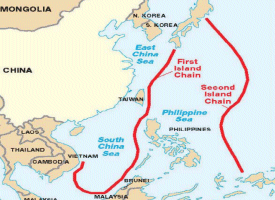
Maritime Posturing –Concept of Operations.
Traditionally, China believed in layered defence based on the concept of first and second Island line defence. While the first line of defence was linked to the inner line of Islands, the second line of defence extended outwards to include Japan.
With the modernization of its maritime forces, it is obvious that China is trying to break free from the shackles of the self imposed twin lines of Island defence and move its area of operations/influence outwards beyond the South China Sea through Malacca Straits to the centre of Indian Ocean Region which is becoming the Centre of Gravity of maritime arena. China has already trained its naval pilots for carrier landing and the expectations are that the old Varyag would be inducted as the first Carrier of PLA-Navy.
There are simultaneous initiatives to wrest the advantage from the US Carrier Task Force by developing long range Anti Ship Ballistic Missile (ASBMs) that could target big war ships. The ASBM obviously provides China an answer to overcoming the restriction on its forces in the South China Sea.
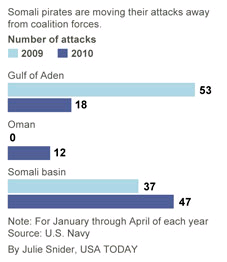
Maritime Terrorism/ Piracy.
This has been one of the most compelling factors for China’s interest in Indian Ocean Region as brought out earlier while discussing the factors for Chinese maritime ambitions in IOR.
The graph and the diagram bring out the threat of piracy to merchantmen which has assumed alarming proportions close to our coast. gone up and there are no signs of letting up. The numbers below indicate that the threat is not diminishing. On the contrary, the pirates are getting bolder with each attack and are making deeper forays in to the Indian Ocean.
China is as concerned or even more than others and has acted promptly by deploying its modern war ships for anti piracy missions. Since the threat of Piracy is not going away, one can safely assume that there would be sustained presence of the PLA-Navy units in the troubled waters.
India’s maritime posturing of Interest to China.
India a Regional power in its own right has made attempts to secure what can be legitimately considered its back yard.
However, some of the actions initiated have been reactive to Chinese actions. In many cases, the actions taken have been too little and too late. Notwithstanding this, it is worthwhile looking at some of the possible issues of concern to China.

These concerns have to be seen in the light of the statement of a Chinese Admiral who had gone on record to say that Indian Ocean is not India’s ocean.
a) Cooperative arrangements with maritime forces of Japan, Vietnam, US,UK,France,Australia, Singapore, Thailand, etc.
India is reaching out to the maritime neighbours of China by engaging the maritime forces of the countries being visited at regular intervals. Such visits have galvanized the regional cooperative mechanisms particularly in the field of disaster relief and SAR. In addition, such interactions enable the Navies in different parts of the world to work out Standard Operating Procedures, work out inter operability issues and keep templates ready for both war and peace. The Navies and the Coast Guards of the region in the Asia Pacific do look at India and Japan as balancing forces in the region to thwart any Chinese advances. India therefore is required to engage Chinese neighbours with purpose and intent to bring out the required balance.
b) Cooperative Initiatives in the neighbourhood.
While not exactly matching China event by event, India has also upped the ante in terms of engaging its maritime neighbours. The maritime neighbours would be quite happy with the sense of competition between the two Asian giants which pays them rich dividends in terms of economic investments and development. Therefore, one sees India also engaging in projects in Sri Lanka, Bangladesh, Myanmar and Maldives. India has also nurtured excellent maritime relations with Seychelles and Mauritius. While India does lag behind by over two decades in terms of its economic liberalization there are strengths that have attracted many players who prefer India to China for some interesting reasons.
c) Proposed security pact with Maldives and increased engagement in security related issues.
The proximity of Maldives and the past record of India rushing to its aid when threatened by mercenaries have helped India to maintain cordial relations and engage its Arabian Sea neighbour both economically and in strategic terms. The frequent exchanges and the training being offered to the security forces have helped in cementing the relations.
d) Launch of INS Arihant –ATV.
The induction of the nuclear capable submarine Arihant would provide the much needed second strike capability as part of the Triad. Though it would take some time before this component of the Triad becomes fully operational it is clear that India is charting the right course. India has a declared policy of ‘no first use’ of nuclear weapons.
e) Modernisation of India’s maritime assets.
While the Indian Navy may be lagging behind in terms of sea based nuclear forces, in terms of its modern naval platforms centered around a Carrier, the IN is a reckonable force which has demonstrated its potential both during peace and war. While it has resolved its differences on the cost of acquisition of the Soviet era Carrier, Gorshkov it is building its own carrier in Cochin Ship Yard to be named Vikrant. India is also adding to its infrastructure potential in the maritime sector by creating new ports and allowing private players to participate in building ships for the Navy and the Coast Guard. The mix of both indigenous and imported modern ships has given the Indian Navy a qualitative edge in the region. Indian Navy in addition enjoys a geographic locational advantage. It also has a strategic maritime edge due to the location of its far flung Island territory both on either flank in the Arabian Sea and in the Andaman Sea.
f) Infrastructure improvements.
India has shed its past inhibitions about augmenting its defence preparedness in strategic areas of Arunachal Pradesh and has also been modernizing its Navy, Air Force and the Army.
g) Assertive India?
With the increasing military might, economic clout and also an increased public perception that India is too defensive, India in the recent past has displayed a degree of assertiveness much to the consternation of China. The notable incidents that bring out this aspect of new assertiveness is related to the participation in the Noble award ceremony for a Chinese Scholar, holding firm ground on Dalai Lama’s visit to Arunachal Pradesh, omission of the references to one China ,post the visit of the Chinese Premier in December 2010, and the firm handling of the stapled visas to Indian visitors from disputed areas.
Conclusion
With the increased importance and use of the seas in the 21st century , the Indian Ocean area and the Seas surrounding China would witness acute competition between China and its Asian neighbour India. The manifest competition also would be witnessed in the Pacific Theatre in one form or another. Conflict for supremacy in IOR by boh direct and indirect means would continue. Cooperation (anti piracy/counter terrorism/HADR) where convenient would continue between other likeminded maritime nations in the Asia Pacific region including India.
From the Indian point of view, the geo strategic advantage enjoyed by India would need to be supported by maritime military might, astute policies and assertive engagement with stake holders, to keep China at bay. Enhanced cooperation with China’s maritime neighbours in peacetime operations needs vigorous attention.
As far as the immediate maritime neighbourhood of China is concerned, the area would be beset with ownership claims and tensions amongst traditional rivals. China would like these to be resolved on its terms. However, the maritime neighbours Japan, South Korea, Vietnam, Indonesia, and Malaysia, Philippines, Brunei and others would not like to let go of their claims about maritime assets in the region which hold promise of energy sources. In one sentence it could be said that the implications of China’s rise for regional stability are enormous and has the potential of bringing about imbalances and acute differences in the region. This in turn would bring in super power presence and add to the tensions in the region which would change the maritime dynamics both in the Seas adjacent to China and in the Indian Ocean.
(The author is presently the Head, Strategy and Security Studies at the Center for Asia Studies at Chennai and can be contacted at [email protected])
